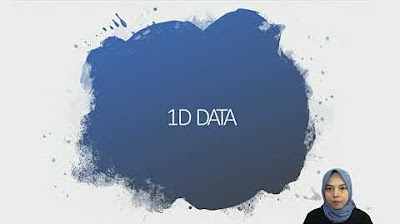Bar Charts, Pie Charts, Histograms, Stemplots, Timeplots (1.2)
Summary
TLDRThis video script introduces various data visualization tools, including bar charts, pie charts, histograms, stem plots, and time plots. It explains how bar and pie charts are used for categorical data, while stem plots, histograms, and time plots are suited for quantitative data. The script delves into reading histograms, converting frequency distributions to relative frequency distributions, and the construction of stem plots. It also covers the use of split stem plots, trimmed leaves, and back-to-back stem plots for better data representation and comparison. Time plots are briefly mentioned as a method to display variable changes over time.
Takeaways
- 📊 Bar charts and pie charts are used for displaying categorical data, while stem plots, time plots, and histograms are used for quantitative data.
- 🍕 Pie charts show the relative size of each value in relation to the whole, emphasizing the proportion of each category.
- 📊 Bar charts display frequency on one axis and categorical variable values on the other, useful for tallying information.
- 📈 Histograms display the distribution of data, with frequency or count on one axis and data intervals on the other.
- 📊 To read a histogram, determine the height of the bars to understand how many data values fall within specific intervals.
- 📊 Frequency distributions can be presented in table format, detailing how many data values fall within certain intervals.
- 📊 By convention, histogram intervals do not include the right endpoint, ensuring continuity and avoiding ambiguity.
- 📊 Relative frequency distributions show the proportion of values in each interval in relation to the whole, calculated by dividing each frequency by the total number of data values.
- 📈 Stem plots display each data point, with stems representing all but the last number and leaves representing the last number.
- 🌱 Split stem plots are used when there are too many leaves, by duplicating each stem to better visualize the distribution.
- 📈 Back-to-back stem plots compare two distributions using the same set of stems, useful for comparing groups like males and females.
- 🕒 Time plots display how a variable changes over time, with time on the x-axis and variable values on the y-axis.
Q & A
What types of data visualization tools are discussed in the video?
-The video discusses bar charts, pie charts, histograms, stem plots, and time plots as data visualization tools.
Which data types are bar charts and pie charts typically used for?
-Bar charts and pie charts are typically used for displaying categorical data.
How does a pie chart represent data?
-A pie chart represents data by showing the relative size of each value in relation to the whole.
What is the difference between a bar chart and a histogram?
-A bar chart displays frequency on one axis and categorical variable values on the other, while a histogram displays the distribution of quantitative data with frequency or count on one axis and variable intervals on the other.
How can you interpret the height of a bar in a histogram?
-The height of a bar in a histogram indicates the number of data values that fall within a specific interval.
What is a frequency distribution and how can it be presented?
-A frequency distribution is a way to show how many data values fall within certain intervals. It can be presented in a table format or as a histogram.
Why might the convention of not including the right endpoint in histogram intervals be used?
-This convention ensures that each data value falls into a single interval, avoiding ambiguity and maintaining continuity in the data representation.
What is the difference between a frequency distribution and a relative frequency distribution?
-A frequency distribution shows counts of data values within intervals, while a relative frequency distribution shows the proportion of values in each interval in relation to the whole dataset.
How can you convert a frequency distribution into a relative frequency distribution?
-To convert a frequency distribution to a relative frequency distribution, divide each frequency by the total number of data values.
What is a stem plot and how does it represent data?
-A stem plot is a visualization tool that shows each data point with stems and leaves. Stems represent all numbers except the last, and leaves represent the last number of a data point.
What is a back-to-back stem plot and what is its purpose?
-A back-to-back stem plot is a variation of the stem plot used to display and compare two distributions using the same set of stems, allowing for easy comparison between different groups of data.
How are time plots used to represent data?
-Time plots are used to show how a variable changes over time, with time typically on the x-axis and variable values on the y-axis.
Outlines

Cette section est réservée aux utilisateurs payants. Améliorez votre compte pour accéder à cette section.
Améliorer maintenantMindmap

Cette section est réservée aux utilisateurs payants. Améliorez votre compte pour accéder à cette section.
Améliorer maintenantKeywords

Cette section est réservée aux utilisateurs payants. Améliorez votre compte pour accéder à cette section.
Améliorer maintenantHighlights

Cette section est réservée aux utilisateurs payants. Améliorez votre compte pour accéder à cette section.
Améliorer maintenantTranscripts

Cette section est réservée aux utilisateurs payants. Améliorez votre compte pour accéder à cette section.
Améliorer maintenantVoir Plus de Vidéos Connexes

Statistika 06 | Visualisasi Data dalam Statistika | Data Visualization | Belajar Statistika

Which is the best chart: Selecting among 14 types of charts Part II

Statistika - Penyajian Data Eps.2 l Ruang Belajar #StudyWithDiida

Data Visualization Tutorial For Beginners | Big Data Analytics Tutorial | Simplilearn

PSD - Data Visualization Part.02/02

How to pick the "perfect" chart for your situation in Power BI?
5.0 / 5 (0 votes)
